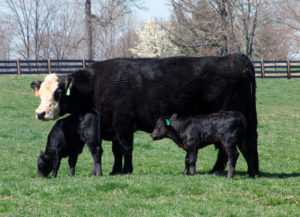Causes Of Common Reproductive Problems
23 August 2017There are a number of factors which can contribute to different reproductive problems in herds and flocks, and it is worth considering which could be the cause of any problems in your case. Identifying the cause will enable preventative measures to be put in place for the next calving or lambing, and reduce the chance of the same happening again. Some common reproductive problems and the reasons for them are –
Poor Fertility
Poor fertility can arise for a number of different reasons, the main ones are shown below. However, it is important to note that any disease or poor body condition will impact upon an animal’s fertility as well as conditions which specifically affect the reproductive tract. Some conditions which appear to be infertility will be due to early loss of the embryo.
Possible causes in sheep:
 Ram infertility
Ram infertility- Insufficient number of rams used, particularly where ewes have been synchronised
- Lameness in the ram
- Previous uterine infection or a difficult lambing
- Poor body condition at tupping
- Diseases causing poor body condition, such as Johne’s disease, maedi-visna
- Toxoplasmosis or Border disease
- Any condition causing a high temperature, such as tick-borne fever
- Selenium or iodine deficiency
Possible causes in cattle:
- Failure of the bull to perform, or poor bull fertility
- Other diseases in bulls, such as lameness, back problems
- Campylobacter infection, Leptospirosis infection and/or BVD infection
- Any infection which causes a high temperature
- Painful conditions in cows or heifers, such as lameness
- Diseases or deficiencies causing poor body condition, such as Johne’s disease, chronic pneumonia
- A previous difficult calving or uterine infection
- Negative energy balance during late pregnancy and early lactation and poor body condition in cows at calving increases the time period after calving in which cows don’t cycle
- Heifers not reaching puberty soon enough, due to low daily liveweight gains during the rearing period
- Cows calving at the end of a prolonged calving period not being given enough time to recover
- Congenital defects in the reproductive tract
Retained Cleansings In Cattle
 The following factors increase the risk of retained foetal membranes:
The following factors increase the risk of retained foetal membranes:
- Premature calvings, including late term abortions and cases where a cow has been induced
- Twins
- Difficult calvings – caesarean section
- Hypocalcaemia
- Infection of the placenta
- Hydrops (an accumulation of an abnormally large volume of fluid in the uterus)
- Stress in late pregnancy
- Vitamin E and selenium deficiency can increase the risk of retained foetal membranes, but it is worth blood sampling a selection of cows in late pregnancy to see if there is evidence of deficiency before treating
Vaginal Or Uterine Prolapses
Vaginal prolapses can occur due to:
- Poor conformation
- Excessive body condition score
- Multiple calves or lambs
- Lameness, leading to long periods of recumbency
- In sheep, high forage diets, particularly root crops
- Limited exercise in housed ewes
Uterine prolapses can occur in association with:
- A difficult calving, particularly a large calf or lamb which has been stuck in the birth canal
- Hypocalcaemia
- Straining following damage or infection in the reproductive tract
Katrina Henderson, katrina.henderson@sac.co.uk
Sign up to the FAS newsletter
Receive updates on news, events and publications from Scotland’s Farm Advisory Service

